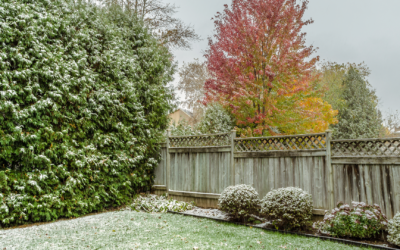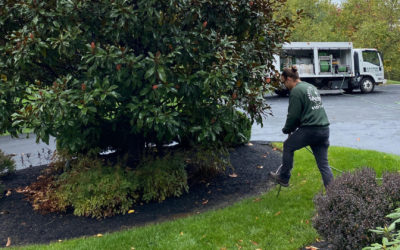As we enter mid-fall we notice that all of our trees display a noticeable change in their appearance. The heat of summer has given way to cooler and shorter days. The green leaves begin to fade and uncover their bright colorful red, yellow, and orange pigments. This is a normal physiological change that all deciduous trees experience before the leaves fall off before winter arrives.
This bright display is similar to the early spring when certain trees flower. Many clients seek out trees that display great fall color. Sugar Maples and Red Maples are top of this list. Tree cultivars have been specifically selected because of their fall color. Two Red maple cultivars that provide the best fall color are ‘October Glory’ and ‘Red Sunset’. Two Sugar maple cultivars that provide the best fall color are ‘Fall Fiesta’ and ‘Green Mountain’.
Other notable large deciduous trees with brilliant fall colors are Ginkgo, Black Gum, and Swamp White Oak.
There are many smaller ornamental trees that also put on a fall show. Native trees like Sourwood, American Dogwood, and Franklinia display deep reds, while Redbuds turn yellow.
While they are evergreen many trees like Pines, Spruce and Arborvitae also display fall color. Evergreens do not lose their foliage for the winter but instead shed older interior needles. The native and ubiquitous Eastern White Pine is the most noticeable to show yellowing. The interior foliage of Arborvitae is orange and red.
The most unique group of trees is deciduous evergreens. While these plants are considered evergreens due to their physiology. Their foliage completely turns shades of orange or yellow and then completely falls off like oaks and maples. Two very similar trees are in this group, the native Bald Cypress and the introduced Dawn Redwood. Both trees turn shades or oranges before the needles drop. A more exotic and unique tree in this category is the Golden Larch. The Golden Larch is slower growing than the other trees and has yellow fall color.
The evergreen and semi-evergreen trees often are cause for concern as we head into the fall for homeowners that are unfamiliar with this natural occurrence. In some years this occurrence is more noticeable than in others. There are some pests that can cause similar color changes. Mites and scale are two common insects that feed on evergreen needles causing them to change color.
The weather always plays into how well and how long the fall color will be. A long hot and dry summer is very stressful on trees and can cause them to start showing fall color by the end of summer. A hard frost can also cause the leaves to drop earlier than normal or shorten the time the leaves stay on the tree.
After the fall foliage has left us there are still a few ways to enjoy color in the garden. The Winterberry holly is a native shrub known for bright red berries that persist throughout the winter. The red fruit of American Holly is also showing up in the garden by mid to late fall.
All trees and shrubs show an array of attributes throughout the year. The fall perhaps provides the most interesting and pleasing as the entire forest canopy shines brightly before winter arrives.
Interested in learning more about how Arader Tree Service can best support your Tree Care needs? Contact Us Today.
What Type of Trees to Plant For a More Vibrant Fall Foliage




